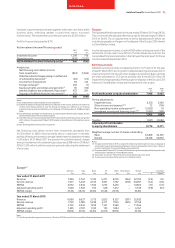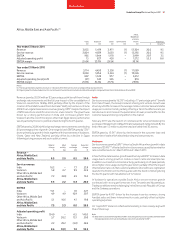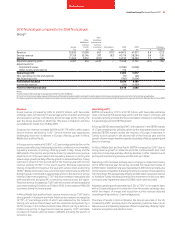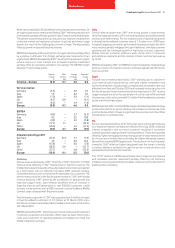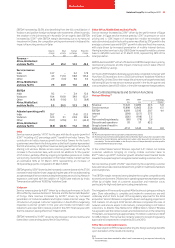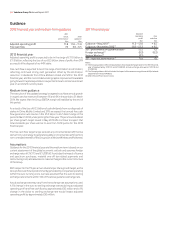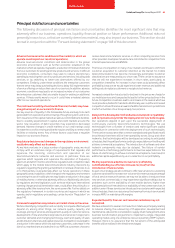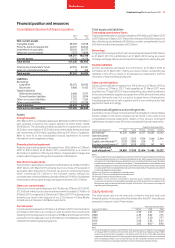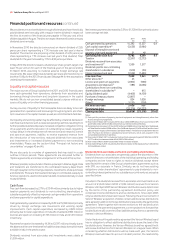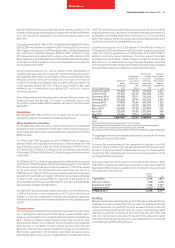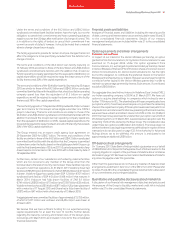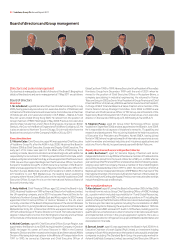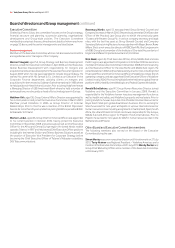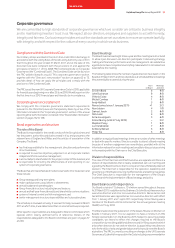Vodafone 2011 Annual Report Download - page 47
Download and view the complete annual report
Please find page 47 of the 2011 Vodafone annual report below. You can navigate through the pages in the report by either clicking on the pages listed below, or by using the keyword search tool below to find specific information within the annual report.
Vodafone Group Plc Annual Report 2011 45
Performance
The following discussion of principal risk factors and uncertainties identies the most signicant risks that may
adversely affect our business, operations, liquidity, nancial position or future performance. Additional risks not
presently known to us, or that we currently deem less material, may also impact our business. This section should
be read in conjunction with the “Forward-looking statements” on page 148 of this document.
receive telecommunications services or other competing services from
other providers. Examples include but are not limited to competition from
internet based services and MVNOs.
The focus of competition in many of our markets continues to shift from
customer acquisition to customer retention as the market for mobile
telecommunications has become increasingly penetrated. Customer
deactivations are measured by our churn rate. There can be no assurance
that we will not experience increases in churn rates, particularly as
competition intensifies. An increase in churn rates could adversely affect
profitability because we would experience lower revenue and additional
selling costs to replace customers or recapture lost revenue.
Increased competition has also led to declines in the prices we charge for
our mobile services and is expected to lead to further price declines in the
future. Competition could also lead to an increase in the level at which we
must provide subsidies for handsets. Additionally, we could face increased
competition should there be an award of additional licences in jurisdictions
in which a member of our Group already has a licence.
Delays in the development of handsets and network compatibility
and components may hinder the deployment of new technologies.
Our operations depend in part upon the successful deployment of
continuously evolving telecommunications technologies. We use
technologies from a number of vendors and make significant capital
expenditure in connection with the deployment of such technologies.
There can be no assurance that common standards and specifications will
be achieved, that there will be inter-operability across Group and other
networks, that technologies will be developed according to anticipated
schedules, that they will perform according to expectations or that they will
achieve commercial acceptance. The introduction of software and other
network components may also be delayed. The failure of vendor
performance or technology performance to meet our expectations or the
failure of a technology to achieve commercial acceptance could result in
additional capital expenditure by us or a reduction in our profitability.
We may experience a decline in revenue or profitability
notwithstanding our efforts to increase revenue from the
introduction of new services.
As part of our strategy we will continue to offer new services to our existing
customers and seek to increase non-voice service revenue as a percentage
of total service revenue. However, we may not be able to introduce these
new services commercially or may experience significant delays due to
problems such as the availability of new mobile devices, higher than
anticipated prices of new devices or availability of new content services. In
addition, even if these services are introduced in accordance with expected
time schedules, there is no assurance that revenue from such services will
increase ARPU or maintain profit margins.
Expected benefits from our cost reduction initiatives may not
be realised.
We have entered into several cost reduction initiatives principally relating
to network sharing, the outsourcing of IT application, development and
maintenance, data centre consolidation, supply chain management and a
business transformation programme to implement a single, integrated
operating model using one enterprise resource planning (‘ERP’) system.
However, there is no assurance that the full extent of the anticipated
benefits will be realised in the timeline envisaged.
Adverse macroeconomic conditions in the markets in which we
operate could impact our results of operations.
Adverse macroeconomic conditions and deterioration in the global
economic environment, such as further economic slowdown in the
markets in which we operate, may lead to a reduction in the level of demand
from our customers for existing and new products and services. In difficult
economic conditions, consumers may seek to reduce discretionary
spending by reducing their use of our products and services, including data
services, or by switching to lower-cost alternatives offered by our
competitors. Similarly, under these conditions the enterprise customers
that we serve may delay purchasing decisions, delay full implementation
of service offerings or reduce their use of our services. In addition, adverse
economic conditions may lead to an increased number of our consumer
and enterprise customers that are unable to pay for existing or additional
services. If these events were to occur it could have a material adverse
effect on our results of operations.
The continued volatility of worldwide financial markets may have
a negative impact on our access to finance.
Our key sources of liquidity in the foreseeable future are likely to be cash
generated from operations and borrowings through long-term and short-
term issuances in the capital markets as well as committed bank facilities.
Due to volatility experienced in capital and credit markets around the
world, new issuances of debt securities may experience decreased
demand. Adverse changes in credit markets or our credit ratings could
increase the cost of borrowing and banks may be unwilling to renew credit
facilities on existing terms. Any of these factors could have a negative
impact on our access to finance.
Regulatory decisions and changes in the regulatory environment
could adversely affect our business.
As we have ventures in a large number of geographic areas, we must
comply with an extensive range of requirements that regulate and
supervise the licensing, construction and operation of our
telecommunications networks and services. In particular, there are
agencies which regulate and supervise the allocation of frequency
spectrum and which monitor and enforce regulation and competition laws
which apply to the mobile telecommunications industry. Decisions by
regulators regarding the granting, amendment or renewal of licences, to us
or to third parties, could adversely affect our future operations in these
geographic areas. In addition, other changes in the regulatory environment
concerning the use of mobile phones may lead to a reduction in the usage
of mobile phones or otherwise adversely affect us. Additionally, decisions
by regulators and new legislation, such as those relating to international
roaming charges and call termination rates, could affect the pricing for, or
adversely affect the revenue from, the services we offer. Further details on
the regulatory framework in certain countries and regions in which we
operate, and on regulatory proceedings, can be found in “Regulation” on
page 140.
Increased competition may reduce our market share and revenue.
We face intensifying competition and our ability to compete effectively will
depend on, among other things, our network quality, capacity and
coverage, pricing of services and equipment, quality of customer service,
development of new and enhanced products and services in response to
customer demands and changing technology, reach and quality of sales
and distribution channels and capital resources. Competition could lead to
a reduction in the rate at which we add new customers, a decrease in the
size of our market share and a decline in our ARPU as customers choose to
Principal risk factors and uncertainties


